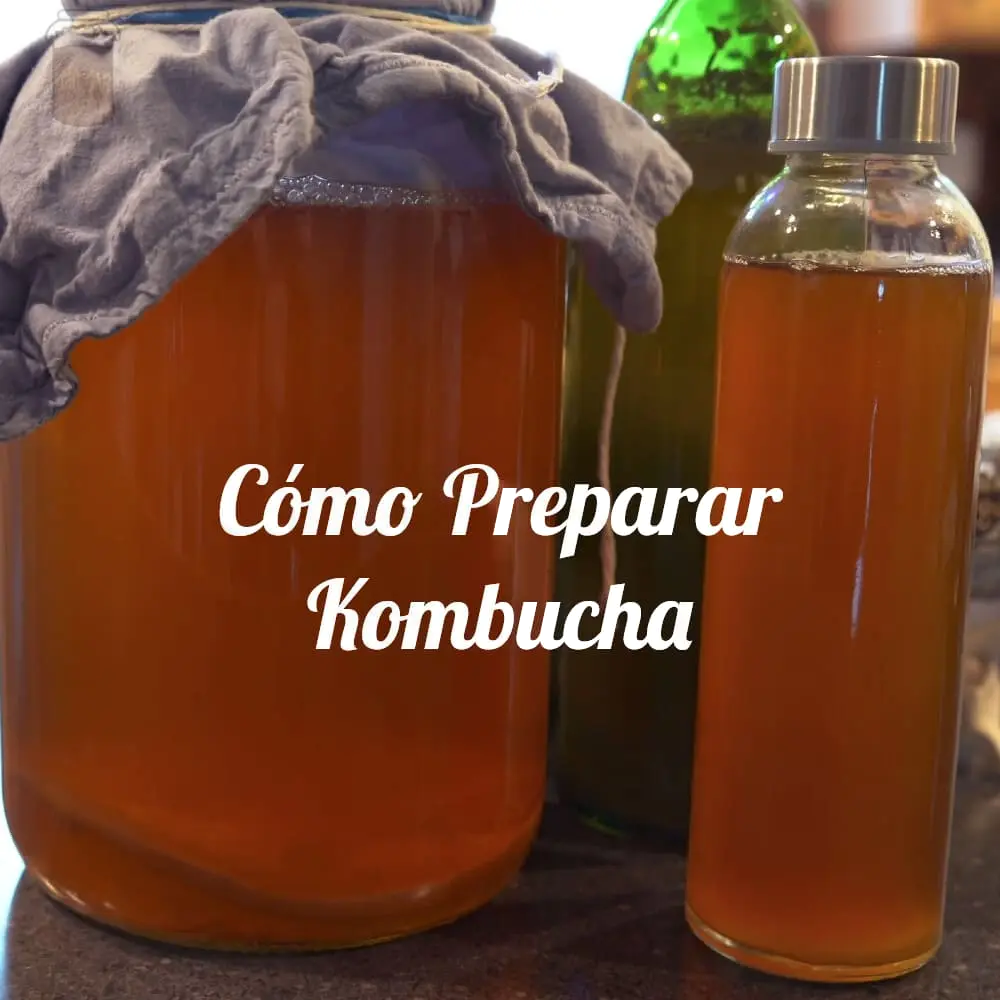For kombucha, it is important to take into account certain aspects to obtain our delicious remedy, but when you can not follow the steps properly for its elaboration you still have other alternatives.
Kombucha has a traditional way of preparing it, but you can also choose (on your own or because you do not have the conditions) other forms related to how to make a starter, substrates to feed microorganisms, how to ferment, among other means that will be useful to obtain your usual kombucha or even improved.
What does it take to make kombucha?
If we talk about ingredients for kombucha, these are few and quite simple to obtain, being sugar, tea, starter liquid (kombucha already fermented) and SCOBY the basic and most recommended to make kombucha, although other aspects of vital importance must also be taken into account such as healthiness and the right environment to ferment kombucha.
The recipe for making kombucha requires tea (black, green, oolong, etc.) and sugar to sweeten, the most used being table sugar. These ingredients function as a substrate to feed the culture of bacteria and yeast found in the SCOBY, which will be added to start fermentation.
First you need to take into account that any changes caused by the environment can affect the characteristics of the drink you want to get, therefore, in addition to the ingredients you need a clean space with sterile containers and utensils.
You can check the post about kombucha containers, necessary for fermentation.
Also a storage place in good condition that is not harmed by changes in temperature or is in direct contact with the sun. [1]
How to prepare kombucha?
You must follow a series of steps that involves boiling the tea leaves or plants for a few minutes, sweetening, transferring to a container inoculating it with a piece of the SCOBY. [2]
First you must prepare the tea, either with a bag of this or using the leaves directly, filtering it for 5 to 10 minutes, and then add sugar while it is hot until it dissolves well, after it has been mixed you must let it cool to room temperature to use it in the preparation of kombucha.
Then proceed to add a SCOBY next to 100 or 200 ml of previously fermented kombucha per liter of tea. This helps lower the pH by protecting the broth against other invading microorganisms and spoilage, as explained in the kombucha pH guide.
Now try to keep it at room temperature at all times and put a clean towel as a lid to protect it from mosquitoes, because as we saw in kombucha and mosquitoes, they love the sweetness of kombucha.
Never close the jar with its lid or you will stop the fermentation rate. We will talk about fermentation in the next section.
At the end of the fermentation, you must refrigerate the kombucha to stop the fermentation, otherwise it will become very acidic, but you will also achieve a very relaxing gaseous effect, since you usually have to transfer the kombucha to bottles. If you want to see how to carbonate or gasify kombucha, click on the link. [1]
How to ferment kombucha?
There are many aspects that influence during fermentation such as pH, temperature, amount of oxygen, dissolved CO2 and broth composition, and any variation can affect the fermentation process and therefore the kombucha obtained. I invite you to read about the fermentation of kombucha in the specific post. [1] [2]
After preparing the tea and adding the starter you should verify that it maintains an optimal temperature to ensure microbial growth (20 ° C to 25 ° C) This is probably the most critical aspect to obtain a good kombucha. [1] [2]
The beverage should be fermented in an average of 15 days, while you must monitor and control the temperature received to the broth, so that microbial growth and enzymatic activity during fermentation will not be interrupted. [2]
The fermentation rate, organoleptic properties and nutritional quality of the beverage may be impaired if certain measures for kombucha fermentation are not met. The quality of the fermentation will depend on the time and the starter culture used that will affect the final composition of the drink. [3]
How much tea should I use and how long should I steep it to make kombucha?
The tea must be added in a percentage associated with the amount of sugar to be used, they can be prepared by letting them soak in a time of 5 to 10 minutes and then add sugar, with 80g / L on average (in general 50g-150g / L), the preparation can be adjusted to different temperatures, amounts and periods of time appropriate to the type of tea used.
Tea bags can come from different types such as blackberry, rosehip, blueberry, or the classic black or green tea, among other flavors, you should check the grams and measure the amount of sugar needed based on this, for example, with black tea it is normally used at a rate of 10 g / L with 5 to 8% sugar (sucrose). [4] [5]
You can also combine 8 g / L of tea with 100 g / L of sugar and 1 liter of distilled water hot at 90 ° C, or 4.36 g / L and 10% sugar. [6] [7]
Tea leaves can be 1% in 10% sucrose in 500 ml of sterilized distilled water, in this case it is boiled for 15 minutes and can be green, oolong or black tea leaves. [8]
The soaking time and temperature affect the content of flavonoids and anthocyanins, the biochemical compounds of the tea are lost at elevated temperatures reducing its healthy properties and lowering the quality of the flavor. [5] [9]
How to use the SCOBY to make kombucha?
To start the fermentation you must take a piece of SCOBY, this is a cellulosic biofilm of microorganisms in solid state formed from a previous fermentation of kombucha, which will favor the fermentation by modifying the composition of the broth and generating the kombucha drink. [10]
You can add the SCOBY to the fermentation broth with different concentrations of sugar and when the tea already has the temperature of the room. Use a wooden spoon to raise the SCOBY and float it in the broth, this way you can ensure that it has access to oxygen and can ferment the broth compounds. [10] [11]
If you prepare kombucha in varied climatic conditions or with different temperatures, you can modify the way in which the SCOBY ferments the compounds of the broth generating kombucha with distinctive characteristics, either in taste, aroma or in its properties for health.
You should remove the SCOBY when it has finished fermenting, you can use it to make other kombucha drinks or give them to a friend.
How to make SCOBY for kombucha?
You can make it from another SCOBY formed in another fermentation, either by using a piece or layer of it and letting it grow in some kombucha broth fermented with water or just leave the kombucha at room temperature in a cool place until it eventually reforms a SCOBY from scratch.
To make the SCOBY it is enough to use kombucha without flavor and without any particular addition, you must pour it into a wide-mouthed jar, cover it and let it ferment for 1 week (it should be longer if it is in cold weather) to form a biofilm on the surface, almost like a skin, it will become thicker until it forms a layer. [12]
The more it is used in other fermentations it will increase in size forming several layers as if they were pancakes, the SCOBY will grow adapting to the shape of the surface of the jar, you must make sure to cover your SCOBY to avoid the invasion of flies or mold spores. [12] [13]
SCOBY usually forms more quickly in green tea preparations than with any other tea, including traditional black tea (see green tea kombucha vs. black tea kombucha).
How to make kombucha without tea?
The base substrate for making kombucha (black or green tea) can be replaced by others that can give a drink with different characteristics than usual, even improving some of its health properties, and many of these ingredients are quite accessible in the market.
Wine, milk, fruit juices, plant infusions, Jerusalem artichoke tubers are good alternatives providing nutritional and health benefits.
Others such as sweetened echinacea and winter savory help reduce fermentation as a source of nitrogen and maintain the characteristics of the traditional drink.
You can also use coconut water and grape juice, these like the previous ones improve the therapeutic properties of the drink and its ability to inhibit microbial growth, kombucha with grape juice only need 6 days of fermentation to achieve this, in addition to improving the flavor and aroma of kombucha. [2]
It is important to note that for the long-term health of the SCOBY will require the use of tea yes or yes, since apparently the culture is somewhat dependent on tea catechins, but this is something that is still under evaluation.
See Related Articles

